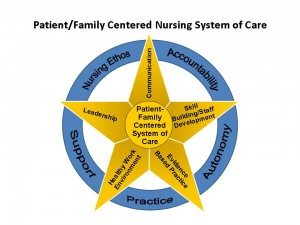 Having a consistent and standardized system of care is the future of Army nursing, Deputy Surgeon General Maj. Gen. Patricia D. Horoho told Madigan Healthcare System senior nurses at a recent presentation.
Having a consistent and standardized system of care is the future of Army nursing, Deputy Surgeon General Maj. Gen. Patricia D. Horoho told Madigan Healthcare System senior nurses at a recent presentation.
The Patient and Family Centered System of Care assures the same standard of health care at every military treatment facility across the Army. That means a patient gets the same high-quality medical care, whether at Eisenhower, Walter Reed, or Madigan. Initially piloted at Blanchfield Army Community Hospital on Fort Campbell, Ky., the program was implemented at Madigan in October of 2009. Most elements of the system of care are expected to be in place at Madigan by the end of April 2010.
“The same way that we do evaluations of our patients and our patient assessments at Madigan needs to be the same way it’s done at every one of our military treatment facilities,” Horoho said. “So, when our civilians and our military members move, they are not having to learn the Eisenhower way, or the Walter Reed way – they’ve learned Army medicine, the Army Nurse Corps way.”
Window of Opportunity
In the history of her military career, Horoho stated she can’t remember a time when every general officer was in 100 percent agreement in supporting a concept and rolling it out so quickly.
“That speaks volumes about the recognition of the value that Army nurses have,” Horoho said. “There are windows of opportunity, where things just all come together. This is one of those windows of opportunity.”
At a time when the entire nation is debating health care reform, Horoho believes that Madigan and the Army Nurse Corps have the opportunity to really help drive changes across the nation and across the world.
“This is a change that not only impacts the health of Army medicine, it impacts military medicine, the health of our nation and – more importantly – we are the drivers of change internationally,” Horoho said.
The Patient and Family Centered System of Care allows patients to have a voice in their care, and includes business practices, clinical practices and professional practices – all focused on patient outcomes that are evidence-based.
“We’ve got to make sure that this change is well thought out, that it’s based on research and evidence, that we’re consistent in how we’re providing it, and that we really continue to measure those changes to make sure that we’re achieving the desired outcome,” Horoho said.
Nursing is Nursing
Lt. Col. Linda Fisher and Maj. Melissa Wallace are the implementation team for deploying the Patient and Family Centered System of Care throughout the Madigan Healthcare System. They both understand Horoho’s vision of standardizing tasks, techniques and procedures throughout the Army Medical Department.
“Nursing is nursing, but the variations on the little things you do, like running an IV pump or admitting a patient, can be different from facility to facility,” Wallace said. “It’s the little things that can add up that make a big difference for the patient – and the nurse, too.”
Since October, Fisher and Wallace helped to establish a council of 18 Madigan nursing personnel to develop a nursing ethics handbook that will soon be distributed to every clinical section. They’ve also instituted Nurse Practice Councils, six section-level committees that allow all nursing staff to reassert their independence over nursing practice.
“All nursing personnel have a voice, no matter where they work,” Fisher said. “These councils are a way for nurses to suggest things and generate ideas.”
The Nurse Practice Councils will also ensure that clinical practice issues from military treatment facilities are reaching the executive level of Army management, driving policy and legislative changes.
“The Army Nurse Corps is not just officers and registered nurses. Its officers, enlisted and civilians from all skill sets. We have to make the policy and structure applicable to everyone,” Wallace said.
Challenges and Changes
Horoho believes there have been dramatic changes in military medicine since 2001. Medical personnel are supporting an Army that is at war, and there are different types of injuries and psychological stress. Army nurses will have to make adjustments in their skills sets and clinical assessments.
And along with changes come challenges. But according to Horoho, challenges only mean that Madigan and the Western Regional Medical Command will direct the transformation to a patient-centered system of care.
“There is tremendous energy across the Army Nurse Corps,” Horoho said. “Madigan and the Western Region are breeding grounds for innovation. We have to look at every single challenge that approaches us and figure out where the opportunity is for us to be the drivers of change.”









